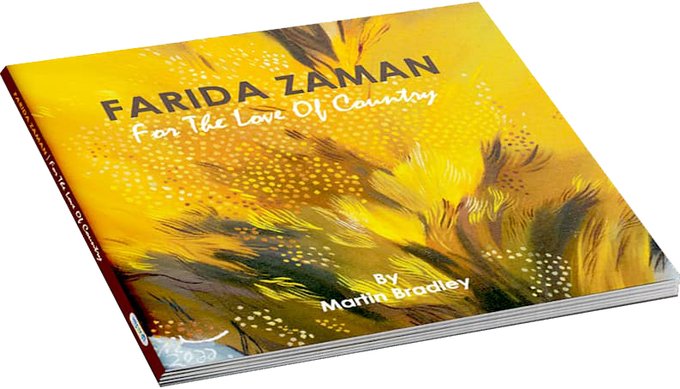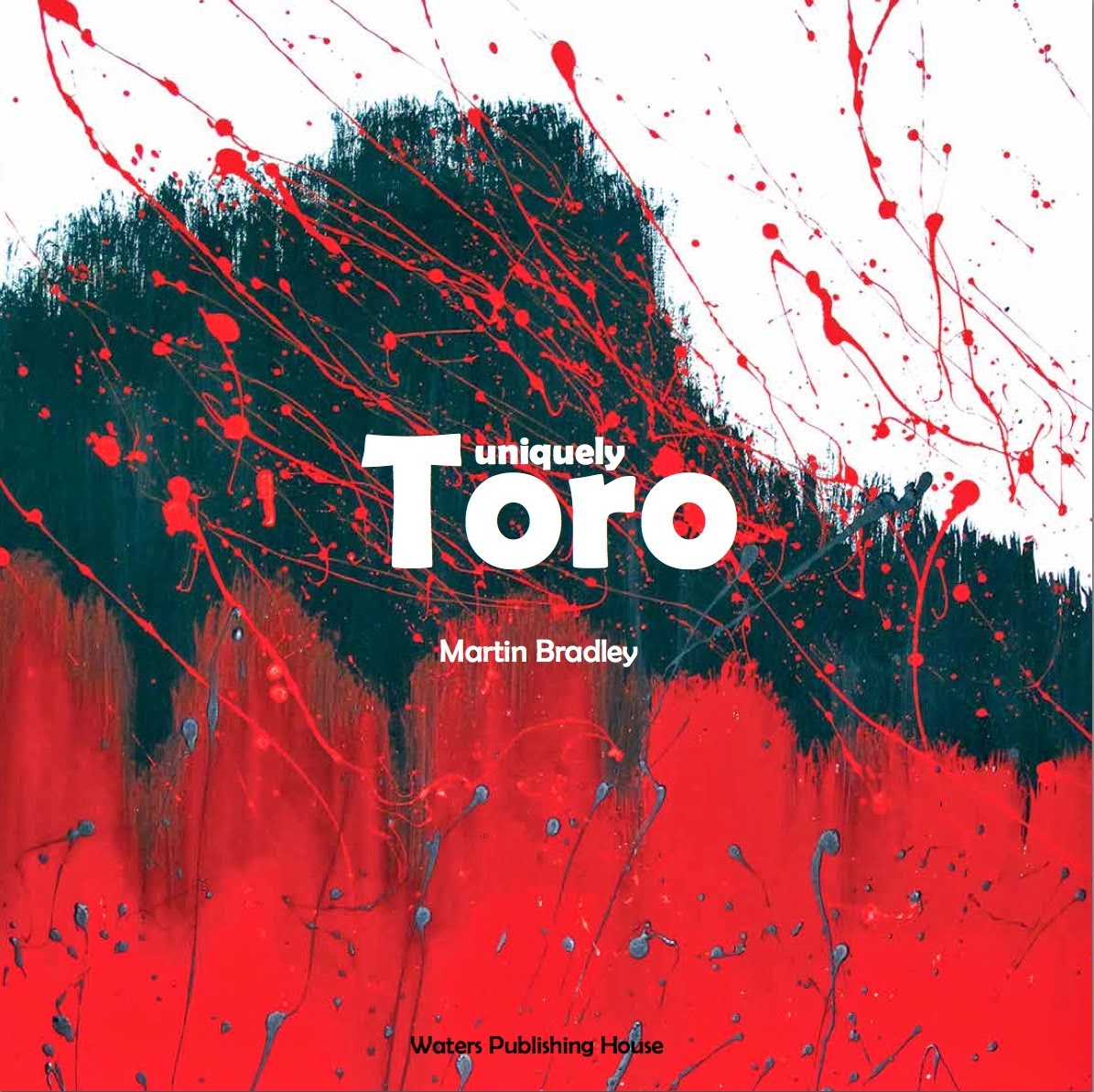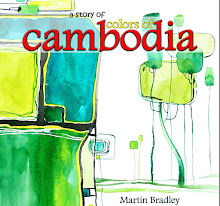Wednesday 26 August 2015
Dr. Cheah Thien Soong’s ‘Lush Forest’
There is a refreshing, unforced, naturalness and homogeneity to the three panelled ink and brush work 'Lush Forest' by Dr. Cheah Thien Soong. Three lengths of Xuan (Shuen) paper, made in the Chinese province of Anhui from natural sandal wood and bamboo fibres, comprise the artist’s semi-abstract artwork. The artist’s bamboo constructed brushes wield a variety of animal hairs for a multitude of distinctive strokes, his black ink deriving from soot, and colours originating from minerals, or other naturally occurring matter.
'Lush Forest' is less graphic than many of the ink brush works Dr. Cheah has created in the recent past. Gone are the imposing tree scenes, the angular counterpoints of black and white and the representative, anthropomorphic waterhens. Instead, Dr. Cheah reveals a soft, yet mysterious, ink and colour wash of a jungle vista. The idea of sequential movement remains, as in sequential art (or comics), in the use of three strips of paper hung side by side, which may be read as movement in comic panels. It is a movement into the notion of ‘Lush Forest’, which in Malaysia may be read as "Jungle", both literal and figurative.
We are not subjected to the wilds of Mungo Park's almost impenetrable jungle (Travels in the Interior Districts of Africa), nor are we lectured by moral laden Mowgli inhabited Indian jungles (Kipling's Jungle Books). But we are guided into a land of South East Asian jungle, noted by Claudius Ptolemy and traversed by Isabella Bird, which is known as the Golden Chersonese. In many respects these three paper strips represent a very real jungle seen, quite literally, at the end of the road that Dr. Cheah’s house inhabits. For he lives on the fringes of a still verdant, equatorial, Kuala Lumpur.
I have mentioned (above) that ’Lush Forest' by Dr. Cheah is a semi-abstract work. Although trained in both Xie He's six principle Classical (vitality, use of brush, depicting form, application of colour, arrangement and observation) and four part Literati (character, knowledge, talent, and thought) influenced styles of Chinese ink brush painting (at the Nanyang Academy of Fine Art, in Singapore) Dr. Cheah soon found that his art school teachers more favoured the freer styles of Chinese Literati painting.
While honouring the great landscape painter Dong Qi-chang, ‘Lush Forest’ becomes a fine example of a new Literati painting, resembling those paintings ever edging towards the abstraction of the Modern Literati movement (China) - a movement emanating from the late 1970s, and forever evolving, perpetuating the Literati essence. Dr. Cheah’s ‘Lush Forest’ is no straightforward Chinese ink and brush painting. Though there may be traditional Chinese symbolism infused in the skill and knowledge of the painter, the images are fine examples of a style indigenous to Malaysia/Singapore - called the Nanyang (or Southern Seas) style, in which Chinese methods and materials are fused with Western concepts and visual iconographies native to the Malay Peninsular and Singapore, e.g. the jungle, as opposed to a gentler Chinese forest.
In this three paper abstraction, Dr. Cheah renders detail enough to hold us to the idea of a mysterious, green, forested land, while simultaneously producing an ephemeral wispiness which holds our imaginations in rapture. ‘Lush Forest’ transports us into jungles real and unreal, jungles of the spirit, philosophical jungles and jungles of our imagination. Layer upon layer of watery brush strokes lead us into an unfathomably complex jungle. There is visual denseness, wrought by intense and deft brushwork, leading to a cloud-like airiness at the top of each picture. It is as if the jungle dissipates into a haze, diluted by keen perspective, as we watch.
Balancing the brush-stroked black ink density is a small white patch at the bottom, centre, of each paper panel. The clarity of the white patch becomes our entrance to the jungle, and the beginning of our journey. The white is, perhaps, the beginning of Lao Tzu’s ‘Tao’ (path or way) guiding us through the tangle and misdirections of human existence and through into spiritual essence . Through the Forest whispers the Ch’i breath, universal Yin and Yang.
The ancient Chinese poet Li Po (Li Bai) has written Why I Make My home in the Mountain forest
You ask O why I’ve chosen to live in the mountains green;
I smile without replying, my heart sedate, serene.
Peach flowers on rivulets gambol, then ramble out of sight; ’tis
Heaven and earth with a difference, not of the world we’d been.
(Translated by Andrew W.F. Wong - Huang Hongfa, 2008)
李白: 山中問答(答俗人)
問余何事(意)棲碧山
笑而不答心自閒
桃花流水杳然去
別有天地非人間
In Dr. Cheah’s three part painting ‘Lush Forest’ we engage our imagination, we chose to make our home, if however temporarily, in that painted ‘forest’, enticed by the artist’s brush work. We observe real and imagined jungle landscapes, paths, calming skies. We hear whispering echoes of an ancient poetry, we sense, in our now heightened imagination, somewhere far where gushing waterfalls spill liquid heaven to taunt tropical jungle fern, and age old eroded rock alike. We feel, simultaneously, the solitude and togetherness of all things, us included, within those ink created equatorial forests on paper created by this master Dr. Cheah Thien Soong.
Dr. Cheah Thien Soong: Harmonious Symphonies
Dr. Cheah Thien Soong’s Harmonious Symphonies (ink and wash on Xuan zhi, 132 by 246 centimetres), magnificently draws contrast between passages of intense, dense, black ink (Mo) and lighter, airier passages of light blue and white, dappled by a fawn brown. The background consists of a seemingly dark, doom laden or foreboding set of mountains, skilfully layered to reveal a jagged multiple mountain range, perhaps Malaysia’s own divisive Titiwangsa, or some Asian Tolkienesque Mordor. It is perhaps dusk, as red/pink streaks the sky amidst hesitant clouds. The dense mountainous background appears to offer little hope, soot black, imposing, whereas the fore and mid grounds slice through the depressive mountains bringing not just hope, but joy and a collective, wondrous, harmony.
It is at dawn and dusk when the ubiquitous light and dark coloured waterhens gather. During the day they are mostly solitary figures, foraging, like domestic hens (from which similarity they draw their names), pecking amidst bushes and the sand around the margins of mining pool lakes, or skirting the dampened rural padi. But at either extreme of the day the Amaurornis Phoenicurus waterhens gather, in communal groups, and socialise, cackling, noisily.
Dr. Cheah, as the painting’s title might suggest, presents his viewers with an eight foot long, Chinese ink brush paper painting of pastural, communal hope, harmony and perhaps a little expectancy too. His common, and plentiful, waterhens are gathered across the bottom of a painting which deftly manipulates its audience’s perspective, much in the manner of a Cubist painting. Jean Metzinger had written (of the Cubists) that they had “uprooted the prejudice that commanded the painter to remain motionless in front of the object, at a fixed distance”. . Curiously, Metzinger in a different article (On Cubism,1912) also praises the spatiality of Chinese painting.… “Do not the Chinese painters evoke space, despite their strong partiality for divergence?” Dr. Cheah Thien Soong both evokes space, in the traditional Chinese way, but also presents varying view points to wield his deft narrative, in ways hinted at by early twentieth century Cubism.
In Harmonious Symphonies the bleak black background is practically flat, yet Dr. Cheah has arranged a positive space of trees to form the foreground. Those trees shoot through the painting to divide those seemingly impenetrable mounting into two halves, the tops of the trees perspectively guide the viewer’s eyes through the painting, and a light blue sky space forms the middle third.
We see the trees as if we are those birds, those waterfowl, gazing from the bottom of the tree trunks, looking upward into the trees’ distance, into their far away branches and towards the serenely blue sky, just as the waterhens might. For a moment, there is a curious interconnectedness between artist and viewer as, momentarily, we become the waterhens and they become us, symbols of us and for us, a benign anthropomorphism perhaps in which the waterhens speak for us, see for us and feel for us. The birds look upwards, in expectation or is it in praise, their sharp beaks pointing to other birds, far off, flying freely in wedged flocks. In the trees, and on ledges, the fluffy, rotund, waterhen young are safe, above ground, protected from predators. The cackle of waterhens has stopped, for a moment’s prayer. The new symphony is a symphony of reverential silence, even perhaps in awe at the free birds distantly flying home, and it is an harmonious one, shared by the waterhen populace.
To the right hand side of the painting, another reverence takes place. A small grouping of waterhens, beaks raised, look up at outlined lotus flowers. To one side of those flowers, on a ledge, sit three waterhen young, one lotus flower bends towards them, perhaps giving grace in its Buddhist symbolism. In the distance, as our eyes follow the positive space giving us the trunk of the tree, another flock of birds fly, almost like a dart, into the distance. On another ledge, opposite to the lotus graced chicks, a couple follow the free flying birds with their beaks, by them are reed like bamboo twigs symbolising perseverance.
There is communal spirit, reverence, growth, safety, harmony, hope and expectation in a painting which constantly disrupts the audience’s view point, and in so doing presents many surprises and delights as the eye follows Dr. Cheah’s lead from the birds, through the trees to the blue sky, and falls back to gorge on the detailed narrative provided by those waterhens. In many senses it is a sequential narrative, akin to the ‘framing’ in comic books. The ‘story’ is told in ‘comic panels’, spaces, trunks of trees, our eyes are encouraged to ‘read’ the painting as you would a comic book. There is even text. But Dr. Cheah uses hand drawn text both as written communication (poem) and as pictorial elements, much in the way the American comic artist Will Eisner might have, to bind text within a complex, engaging, visual narrative.
Subscribe to:
Posts (Atom)








